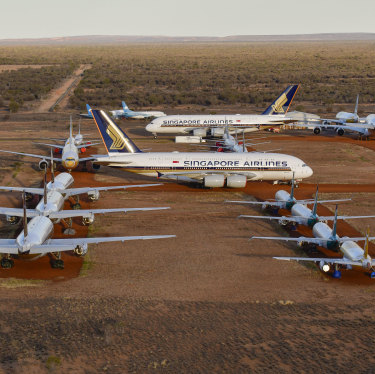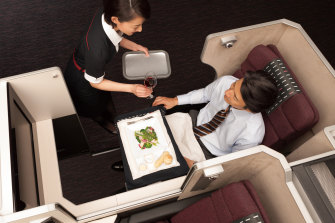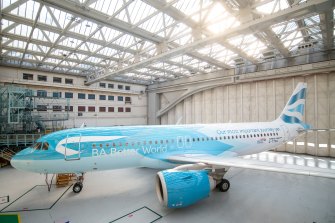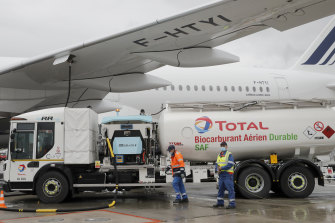One of the most dramatic impacts of the COVID-19 pandemic happened in the skies: they fell silent. Airports sat empty and jetliners were mothballed in desert storage facilities protected from corrosion by the dry heat.
By May 2020, global aviation had slowed to just 6 per cent of what it was before the pandemic. The best estimates were that it would take until 2024 for airlines to recover to 2019 levels of flying.
That makes COVID-19 the biggest setback to aviation since the Second World War, slowing what had been an inexorable growth in flying activity, which had tripled between 2000 and 2019.
As the recovery gradually gains pace – with Australia set to reopen its international border in November – attention will again turn to one of the most pressing concerns about aviation: its impact on the environment and, specifically, its contribution to climate change.
While our homes, workplaces, cars and major industries are going green thanks to the uptake of clean electricity, there is no quick or easy replacement for the CO2-spewing jet fuel that propelled 4.5 billion passengers through the skies in 2019.
So, just how bad for the environment is flying? What’s being done about it? And is it possible to fly “carbon-neutral”?

Airbus A380s, Boeing MAX 8s and other smaller aircraft grounded at a storage facility in Alice Springs in 2020 because of the coronavirus pandemic.Credit:Getty Images
What effect does flying have on the environment?
In a normal year, aviation contributes about 2 per cent of the world’s carbon emissions, according to the International Civil Aviation Organisation (ICAO), which is the United Nations’ aviation body.
Before the coronavirus pandemic, ICAO estimated that aviation’s carbon emissions could triple by 2050, based on the projected continued growth in air travel.
In Australia, domestic flights (which are all that are counted in the government’s National Greenhouse Accounts) made up 1.6 per cent of our total emissions in 2017. When international flights are included, emissions increase to represent 3.8 per cent of Australia’s total. While that’s a lot, it trails our biggest polluters – electricity and heat production (32 per cent of the total), road transport (14 per cent), and methane produced by farm animals (8.7 per cent).
One person flying economy class return from Sydney to London via Singapore is responsible for 1.74 tonnes of CO2, according to the ICAO, which represents 8 per cent of our per capita emissions per year (21.4 tonnes per person).
Your carbon footprint doubles if you splurge for a business-class seat because you take up more space on board, meaning the plane burns more fuel per person compared with a plane that has only economy seats (that’s one reason to feel good being squeezed in the back cabin).
In the face of this, the world’s major airlines (which are represented by a body called the International Air Transport Authority, or IATA) have promised to stop growing their “net” carbon emissions from this year, and in early October pledged to reach “net zero” emissions by 2050.
Airlines face a huge challenge reaching these goals but insist they have the means to do it.

Business-class passengers leave a carbon footprint twice as big as those in cattle class because they take up more space.Credit:
How does carbon offsetting work?
Many people only consider flying’s contribution to climate change when they are asked if they want to pay extra to “fly carbon-neutral” as they book their ticket. If they say “yes”, they pay a few extra dollars on a Melbourne-Sydney flight, or up to $50 on a return trip to London, and that money goes into environmental projects intended to mitigate the carbon impact of the journey. Not many people do this. Qantas says its passengers paid to offset 133,242 tonnes of carbon through its schemes in 2018, amounting to only about 1.1 per cent of the airline’s net emissions.
Qantas says its passengers paid to offset … about 1.1 per cent of the airline’s net emissions.
Climate scientists question the merit of some of the projects that supposedly undo the damage of your flight, many of which involve planting trees or conserving forests. While trees may suck carbon out of the atmosphere, they are part of the active carbon cycle – they absorb carbon when they grow, which returns to the atmosphere if they fall down and decay, or are burnt.
That doesn’t mitigate the impact of releasing carbon that’s been locked up in
the ground for millions of years and is then burnt by airlines as jet fuel, these critics say.
The gold standard for offsetting are schemes that fund clean energy projects, such as building wind or solar farms, which create electricity that would otherwise be produced with fossil fuels, and in that way genuinely offset the carbon from a flight.
Airlines will start relying more and more on offsetting schemes to mitigate their emissions, so that even though the amount of CO2 their planes spit into the atmosphere will keep rising, their net emissions – that is, their actual emissions minus what they offset – will stay at 2019 levels and then eventually fall.
For international air travel, this offsetting is governed by a United Nations scheme called the Carbon Offsetting and Reduction Scheme for International Aviation (CORSIA), which will ensure each carrier has offset its carbon emissions growth properly.
Australia is one of 80 countries, covering three-quarters of the world’s international air travel, to take part in the CORSIA scheme from 2021 before it becomes mandatory for 191 countries in 2027.

In September 2021, British Airways flight BA1476 from London Heathrow to Glasgow Airport was a carbon-neutral flight.
Could biofuels become the new aviation fuel?
Rather than offsetting CO2, it is, of course, better not to release it into the atmosphere in the first place. Airlines boast that they have already made great strides on this front, with per-passenger emissions halving since 1990 as carriers swap fuel-guzzling, four-jet planes such as the Boeing 747 jumbo with newer, more fuel-efficient aircraft such as 787 Dreamliners and Airbus A350s (the main driver being to cut their fuel bills rather than to slow global warming). They say planes will continue to get lighter and be able to fly further with less fuel.
The biggest opportunity to cut emissions in the medium term is to switch from jet fuel refined from petroleum to biofuels. These alternative fuels can be made from vegetable oils derived from seed crops, used cooking oil, algae and even household or forestry waste.
Biofuels can produce up to 80 per cent fewer emissions than conventional jet fuel without significant changes to aircraft engines or airport infrastructure.

Air France-KLM prepares its first long-haul flight with sustainable aviation fuel in May 2021.Credit:AP
The industry specifies it is interested only in sustainable aviation fuels (SAFs) – which are biofuels made from crops that do not require land clearing, do not replace food crops and use water responsibly – to ensure the switch to green fuel does not cause yet more environmental harm.
But fuel is already the single biggest expense for airlines and biofuels currently cost up to four times as much. So, uptake has been negligible, and sustainable aviation fuels accounted for one out of every 10,000 gallons of fuel the global aviation industry guzzled before COVID.
Fuel is already the single biggest expense for airlines and biofuels currently cost up to four times as much.
Several airlines – including Qantas, Lufthansa, Cathay Pacific and United – have made long-term purchasing commitments to encourage biofuel production, while Norway has mandated that its airlines must use 30 per cent sustainable aviation fuel by 2030. Qantas in 2019 committed to spending $50 million over the next 10 years to kick-start a local biofuel industry.
The International Air Transport Authority believes that biofuel uptake needs to hit 2 per cent by 2025 to reach a critical mass of production, after which the cost would start to fall. But it argues that won’t happen without significant government investment to help things along.
Unsurprisingly, while calling for government help, airlines firmly oppose measures such as carbon taxes or levies that would financially give them an incentive to speed up the transition to sustainable fuel themselves.
Modelling commissioned by the British group Sustainable Aviation estimated production of sustainable aviation fuels could lift to between 14.5 and 30.9 million tonnes annually by 2035 – enough to replace only 4 to 8 per cent of the global industry’s current jet kerosene use.
Airlines can use only a 50-50 mix of biofuels with conventional jet fuel because aviation authorities are not yet satisfied that engines can run as reliably and safely with a higher blend. But work is under way to change this. Airbus in March 2021 operated its first test flight using 100 per cent biofuel with an A350 jet, while Boeing announced in January 2021 that all its aircraft would be certified to fly entirely on biofuel by 2030.
Will planes one day run on hydrogen?
The aviation industry is looking beyond oil and even biofuel to a new fuel source that could eradicate carbon emissions from aviation entirely: hydrogen.
The lightest element on the periodic table is increasingly seen as playing a vital role in addressing the climate crisis across a range of industries that cannot easily switch to wind or solar power.
Hydrogen is produced through a process called electrolysis where electricity splits water (H2O) into just the O (oxygen) and the H (hydrogen). When burnt in a combustion engine in liquid or gas form, hydrogen’s only by-product is water vapour.
Most hydrogen production today is powered with fossil fuels. But renewable energy powers the “green hydrogen” that airlines would use if they were to fly carbon-free. It is estimated that more than $194 billion of green hydrogen projects were announced worldwide in 2020.
Loading
Hydrogen-powered flight is nothing new. It’s the main fuel source used in space flight. In 1988, the Russian aircraft maker Tupolev experimented with liquid hydrogen in a modified version of its Tu-154 workhorse, used by Soviet airlines for decades. They called the hydrogen option “ecologically pure”, although back then the reported aim was also to find alternatives to petroleum for when global supplies dwindled.
In the early 2000s, Airbus led a European Union-backed study into the viability of a “cryoplane” – a reference to the need to cryogenically cool liquid hydrogen to transport it. That study found that hydrogen could, with special precautions, be used just as safely as kerosene. But that did not translate into meaningful action.
The final piece of the puzzle is to reduce or eliminate “contrails” – the white streaks of water vapour cloud that form behind a plane.
The concept of hydrogen-powered passenger aircraft was given a major boost in September 2020 when Airbus released concepts for three zero-emission passenger aircraft that it says airlines could be flying by 2035. The planes are all intended to be fuelled by either liquid or gas hydrogen. One is powered with electric turbo-propellers, seating up to 100 passengers; another is a turbofan jet carrying up to 200 passengers; and the third is a jet-powered 200-seater with a revolutionary blended-wing body, which looks more like a kite or fighter jet than a conventional passenger aircraft.
Airbus says it will decide by 2025 which of the concepts to put into production. The hydrogen-combustion engines on the 200-seat jet and blended-wing models would eliminate CO2 from flying (provided they were powered by green hydrogen – that’s the one made with renewables). The smaller propeller aircraft would be powered with hydrogen fuel cells – which work like batteries by converting hydrogen and oxygen into electricity – making it even greener because that would eliminate the greenhouses gases nitrous oxide and sulfur oxide.
The final piece of the puzzle is to reduce or eliminate “contrails” – the white streaks of water-vapour cloud that form behind a plane and affect the Earth’s temperature by blocking both sunlight and radiation reflected back from the planet’s surface.

A Qatar Airways Airbus A 340 airplane leaves contrails in the sky.Credit:AFP
It is thought hydrogen engines will produce thinner and less persistent contrails because they will not emit soot particles for the water vapour to cling on to.
Despite the hype, a shift to hydrogen flying is far from straightforward. One of the biggest challenges is that, although hydrogen fuel is very light, it has poor energy density by volume. That means a lot more space is needed on a plane to carry hydrogen fuel compared to standard jet fuel to fly the same distance. Special storage tanks will be required to cool the fuel to minus-260 degrees.
As a result, Airbus’s three hydrogen concept planes are expected to have a shorter flight range than their petroleum-run equivalents. The manufacturer’s 180-seat workhorse A320s have a range up to 6300 kilometres, and have been used on eight-hour flights from Sydney to Manila, for instance, but the turbofan hydrogen equivalent is set to be limited to about 3700 kilometres, which wouldn’t get you much further than Darwin.
Passenger jets today carry most of their fuel in their wings, but concepts for new hydrogen aircraft have leant towards incorporating them in the plane’s fuselage (the long tube part). This is where Airbus’s new blended-wing aircraft concept comes into its own: it will potentially be able to hold enough fuel in its large frame to fly longer distances.
Another issue is getting hydrogen fuelling infrastructure in place at airports, so planes can be guaranteed they can refuel – a massive undertaking. But don’t try booking a seat on one of these whiz-bang hydrogen planes yet. It is unlikely that hydrogen aircraft will replace existing jetliners in any meaningful number until well beyond the middle of the century, given airlines generally hold on to aircraft for 20 to 30 years.
Aircraft manufacturers rushing to build the next generation of supersonic passenger jets, two decades after the end of the Concord era, have a low-carbon future in mind.
In the nearer term, hydrogen might play a role through the production of synthetic electro-fuels. Created by mixing green hydrogen with CO2 captured from industrial factories, coal or gas-fired power plants or pulled directly from the atmosphere, electro-fuel could supplement other biofuels to lower emissions.
Meanwhile, airlines including Air New Zealand have already been looking at ways to electrify their propeller aircraft using conventional batteries for short-haul flights, with Norway planning for all domestic flights to jettison sustainable fuel and be electric by 2040.
And a group of aircraft manufacturers rushing to build the next generation of supersonic passenger jets, two decades after the end of the Concorde era, have a low-carbon future in mind. British aerospace engineering firm Reaction Engines says its hydrogen-powered jets could propel aircraft from Sydney to Brussels in less than five hours, while Boom Supersonic plans for its 55-passenger jet – which it claims could be operational in 2030 – to be able to run entirely on sustainable biofuel. United Airlines has said it will buy up to 50 of Boom’s jets if they make it off the ground.

An artist’s rendition of Boom Supersonic’s Overture jet. United Airlines has shown interest.Credit:Boom Supersonic
So, should you avoid flying for now?
In Sweden, there’s a word for feeling bad about jumping on a plane – flygskam – or “flight shame”. With no easy or quick solutions to aviation’s climate problem, a growing number of people are choosing not to fly at all.
A European Investment Bank survey in January 2020 found that one in three Europeans said they already flew less for holidays because they were concerned about climate change, and three-quarters said they intended to fly less for that reason in 2020 (not, as it turned out, that they had many opportunities to do so).
So it’s not surprising that other modes of transport are back in vogue. Travel on Sweden’s largest rail network jumped 11 per cent in 2019 and rail operators across Europe are reviving overnight sleeper train services between major cities.
In a sign that airlines are conscious of this shifting landscape, Lufthansa, Air France and Dutch carrier KLM have partnered with rail operators to sell code-share tickets across both sky and land. KLM launched a “fly responsibly” campaign in 2019 encouraging passengers to save time and the environment by taking the rail link between Amsterdam and Brussels rather than flying, while Lufthansa axed its short-haul Frankfurt-Cologne flights due to the success of its alliance with Deutsche Bahn.
French lawmakers moved to accelerate this trend by voting in 2021 to ban all domestic flights on routes that can be covered by train in less than two-and-a-half hours, unless passengers are connecting to an international flight. So, no more flying from Paris to cities such as Nantes, Lyon and Bordeaux.
That followed Austrian Airlines ditching its 45-minute air service between Vienna and Salzburg in favour of more frequent train services with its rail code-share partner in mid-2020, after the Austrian government made cutting short-haul routes a condition of a €600 million ($940 million) pandemic bailout.

Feeling a touch of flygskam? In Europe, travellers like this guy in Vienna are catching trains instead of flying.Credit:Getty Images
Of course, Australians don’t have much choice if they want to travel abroad or even around the country. The absence of fast-rail connections between our vastly separated cities makes us almost uniquely reliant upon air travel. The country has flirted with the idea of high-speed rail since the 1980s but nothing has ever advanced past the planning stage. A bullet train connecting
Melbourne, Sydney and Brisbane would take up to 50 years to build. Critics say the population of those cities is too small to support such a project, unlike the far larger, and closer, cities connected by high-speed rail in Japan, China and Europe.
Loading
In any case, the airline body IATA warns that about 80 per cent of the industry’s CO2 emissions come from flights of more than 1500 kilometres,
for which rail is not a viable replacement.
The long-term impact of COVID-19 on air travel is still unclear. Holidaymakers might be more inclined to travel closer to home in the future, and the post-COVID uptake of video conferencing might eliminate some demand from business travellers. But whatever our travel plans, it’s unlikely the climate clouds hanging over aviation will part any time soon.
Fascinating answers to perplexing questions delivered to your inbox every week. Sign up to get our new Explainer newsletter here.








